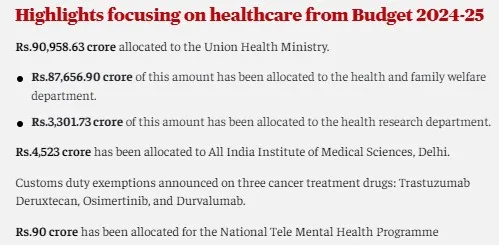Syllabus :GS 2/Health
In Context
- An expert group constituted by NITI Aayog has proposed a new Public Health Emergency Management Act (PHEMA).
About Public Health Emergency Management Act (PHEMA)
- It will address a range of public health issues, including epidemics, non-communicable diseases, disasters, and bioterrorism, through a holistic approach covering prevention, control, and disaster response.
- The Act would also provide for the creation of skilled public health cadres at national and state levels.
- Priority Targets: Developing human resources and infrastructure.
- Creating innovative countermeasures and appropriate high-risk financing.
- Strengthening regulatory frameworks and surveillance networks.
- Connecting epidemiological, genomic, laboratory, and clinical data.
About Public Health Crisis : Challenges and Concern
- India, with its vast population and diverse healthcare landscape, faces several public health challenges.
- Infectious diseases : India grapples with infectious diseases that pose significant threats to public health. For example
- The COVID-19 pandemic has strained healthcare systems, leading to overwhelmed hospitals, shortages of medical supplies, and loss of lives.
- Vector-Borne Diseases: Diseases like malaria, dengue, and chikungunya continue to affect large sections of the population.
- Infrastructure : India’s healthcare infrastructure faces challenges related to funding, infrastructure gaps, and inadequate staffing.
- Rural areas often lack proper medical facilities, leading to disparities in healthcare access.
- Shortage of Healthcare Workers: The shortage of doctors, nurses, and other healthcare professionals exacerbates the crisis.
- Malnutrition and Maternal Health: Despite progress, malnutrition remains a significant concern.
- India still grapples with high maternal mortality rates.
- Non-Communicable Diseases (NCDs) : Diseases like diabetes, hypertension, and cardiovascular conditions are on the rise
- Environmental Health: India faces severe air pollution, especially in urban centers.
- This contributes to respiratory diseases and other health issues.
- India’s public health spending : It has been meager, hovering around 1% of GDP.
- Despite recent increases bringing this closer to 2%, it remains inadequate when compared to global standards.
Initiatives
- National Rural Health Mission (2005) and National Health Mission (2013) focused on strengthening public sector health care.
- Recent policies emphasize publicly funded health insurance (PFHI) schemes like PMJAY
- Economic survey data : As a percent of GDP, expenditure on social services has increased from 6.7% in 2017-18 to 7.8% in 2023-24.
- Correspondingly, health expenditure has increased from 1.4% to 1.9% in the same period.
- Budget Allocation:

Suggestions and Way Forward
- India’s public health crisis demands a multi-pronged approach involving government policies, community participation, and international collaboration.
- Lessons need to be learnt from national and global experiences with COVID-19 to inform future preparedness and response strategies.
- To address the gaps exposed by the pandemic, there must be an increase in public health funding, focusing on both infrastructure and human resources.
- Strengthening the financial support to states is crucial.
- Establishing a strong surveillance network and improving data management will be essential for effective public health responses.
- Investing in the training and development of healthcare professionals is vital.
- Establish health cadres at both national and state levels to improve emergency management.
- Create an Empowered Group of Secretaries on Pandemic Preparedness and Emergency Response (PPER), chaired by the Cabinet Secretary, to coordinate responses.
- Build and maintain a trained workforce ready for rapid response during emergencies and ensure preparedness during peacetime.
- There is a need for establishment of a Pandemic Preparedness and Emergency Response Fund for effective and timely action.
Source: IE
Previous article
India and GCC: Joint Action Plan for 2024-2028